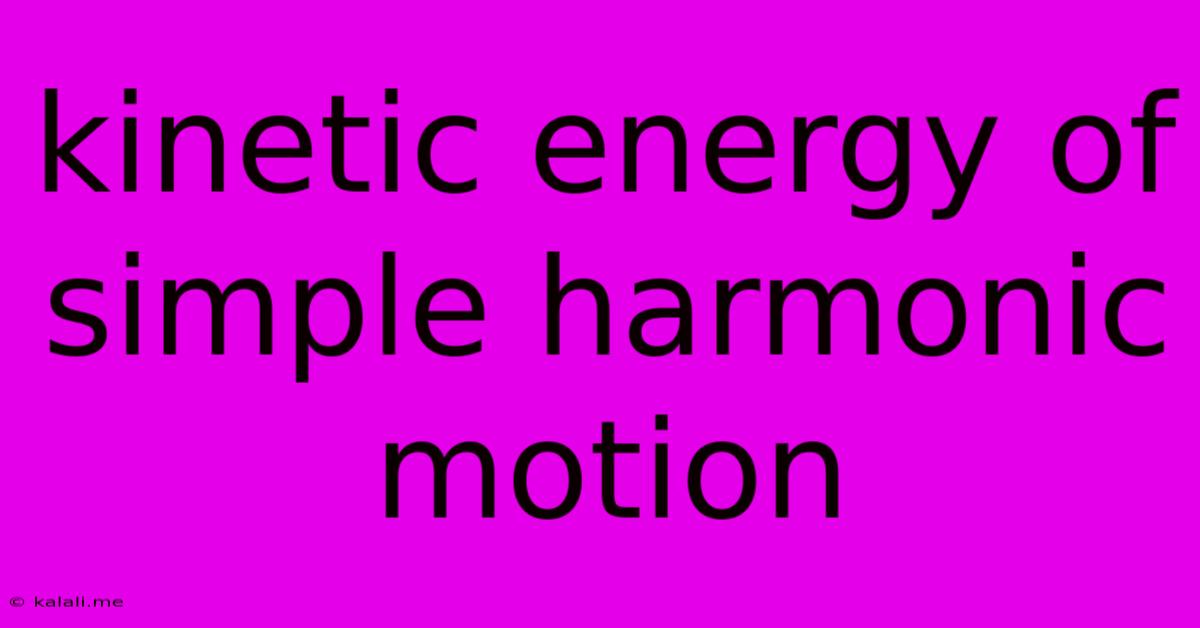Kinetic Energy Of Simple Harmonic Motion
Kalali
Jun 14, 2025 · 3 min read

Table of Contents
Kinetic Energy in Simple Harmonic Motion: A Comprehensive Guide
Meta Description: Understand the kinetic energy of simple harmonic motion (SHM) with this comprehensive guide. We'll explore its relationship with potential energy, derive the kinetic energy formula, and provide real-world examples. Learn how to calculate kinetic energy at any point in an oscillation.
Simple harmonic motion (SHM) is a fundamental concept in physics, describing the oscillatory motion of a system around an equilibrium position. Understanding the energy transformations within SHM, specifically the interplay between kinetic and potential energy, is crucial for grasping its underlying principles. This article delves into the kinetic energy aspect of SHM, providing a clear and comprehensive explanation.
What is Kinetic Energy in Simple Harmonic Motion?
In SHM, the kinetic energy (KE) of a system is the energy it possesses due to its motion. Consider a simple pendulum swinging back and forth. At its lowest point, the pendulum has maximum velocity and therefore maximum kinetic energy. Conversely, at its highest points (the extremes of its swing), the pendulum momentarily stops, possessing zero velocity and thus zero kinetic energy. This constant exchange between kinetic and potential energy is a defining characteristic of SHM.
Deriving the Kinetic Energy Formula for SHM
The kinetic energy of any object is given by the formula KE = ½mv², where 'm' is the mass and 'v' is the velocity. To apply this to SHM, we need to express the velocity in terms of the system's properties. For a system undergoing SHM, the displacement (x) from the equilibrium position can be described by:
x = A sin(ωt + φ)
where:
- A is the amplitude (maximum displacement)
- ω is the angular frequency (ω = 2πf, where f is the frequency)
- t is the time
- φ is the phase constant
Differentiating this equation with respect to time gives us the velocity:
v = Aω cos(ωt + φ)
Substituting this velocity into the kinetic energy formula, we get:
KE = ½m(Aω cos(ωt + φ))² = ½mA²ω² cos²(ωt + φ)
This equation shows that the kinetic energy in SHM is a function of time, oscillating between zero and a maximum value.
Relationship Between Kinetic and Potential Energy in SHM
In a conservative system like ideal SHM (neglecting friction and air resistance), the total mechanical energy (E) remains constant. This total energy is the sum of the kinetic energy (KE) and potential energy (PE):
E = KE + PE
As the system oscillates, the energy continuously converts between kinetic and potential energy. When KE is maximum, PE is zero, and vice versa. This constant energy exchange is a fundamental property of SHM.
Maximum Kinetic Energy in SHM
The maximum kinetic energy (KEmax) occurs when the displacement (x) is zero (at the equilibrium position), meaning the velocity is at its maximum. Substituting x = 0 into the velocity equation, we find the maximum velocity (vmax = Aω). Therefore:
KEmax = ½m(Aω)² = ½kA²
where k is the spring constant (for a mass-spring system) or a related constant representing the restoring force in other SHM systems. This shows that the maximum kinetic energy is directly proportional to the square of the amplitude.
Examples of Kinetic Energy in Simple Harmonic Motion
Several real-world systems exhibit SHM and thus demonstrate the principles of kinetic energy discussed above:
- Mass-spring system: A mass attached to a spring oscillates back and forth. The kinetic energy is maximum when the spring is at its equilibrium position and zero at the maximum displacement.
- Simple pendulum: A pendulum swinging in a small angle approximation exhibits SHM. Its kinetic energy is greatest at the bottom of its swing and zero at the highest points.
- LC circuit: In an ideal LC circuit (inductor and capacitor), the energy oscillates between the electric field of the capacitor and the magnetic field of the inductor, representing potential and kinetic energy analogies respectively.
Conclusion
Understanding the kinetic energy in simple harmonic motion is crucial for comprehending the dynamics of oscillatory systems. By exploring the derivation of its formula and its relationship with potential energy, we can accurately describe and predict the energy transformations within various SHM examples. This knowledge forms the bedrock for understanding more complex physical phenomena that involve oscillations.
Latest Posts
Latest Posts
-
Syllabus Of Gate Exam For Ece
Jun 15, 2025
-
What Is The Human Body Resistance
Jun 15, 2025
-
Elements In Group 3 12 Are Called
Jun 15, 2025
-
Burning A Candle Is A Chemical Or Physical Change
Jun 15, 2025
-
The Most Abundant Molecule In A Cell Is
Jun 15, 2025
Related Post
Thank you for visiting our website which covers about Kinetic Energy Of Simple Harmonic Motion . We hope the information provided has been useful to you. Feel free to contact us if you have any questions or need further assistance. See you next time and don't miss to bookmark.